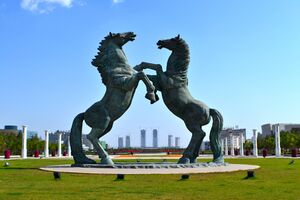Ulämörndün
| "Ulämörndün" | |
|---|---|
 The Ulämörndüncholün sculpture in Nurmgö | |
| Folk song | |
| Written | c. 800 |
| Songwriter(s) | Unknown, possibly Ekkin |
Ulämörndün (Zalyk: ᡉᠯᠠᡏᡈᠷᠨᡑᡉᠨ, Narodyn: Улүямөpндүн; Ulyamorndyn), roughly translated to Song of the Ghost Stallions is a traditional Zalyk, and more broadly Mongolic, folk song mostly used to commemorate the deaths of soldiers after a battle. While writing of the song is apocryphally associated with Ekkin and then later transcribed into the Zalyk language, it is more likely to have been the work of an unknown Zalyk soldier during their Euclean raids throughout the 9th century. Transcriptions of the song have been found dating back as far as 850 CE, and it is almost certain the song was sung in the 9th century to commemorate fallen soldiers. Today it still serves as a popular song throughout the ranks of the Zalyks in the Narozalic Army, although its ceremonial purpose has diminished. The song serves as the regional anthem of Zalykia, when it was changed in 1989.
Initial popularity
The song quickly rose in popularity as a song of remembrance and respect for fallen soldiers during a battle - largely due to the lack of a prior song that fulfilled a similar role. While the song was intended for singing after a battle, it was also often sung during marches, in camps as a folk song and even during battle. Due to the song's association with Ekkin, it became widely popular throughout the ranks of the Zalyk tribesmen and was almost revered as a holy song. The song was also purportedly played after Ekkin's death, which cemented its place at the forefront of Mongolic musical culture.
Content
The song consists of three verses, sung three times over throughout the duration of the song:
Kiitin laa bulgiinnen usnaas ni
Kiriigen ugaagad suulaa laa.
Kiriigen ugaagad suuwuchiki!
Kilimjitai laa eej min andn.
Gashuun laa bulgiinnen usnaas ni
Gariigan ugaagad suulaa laa
Gariigan ugaagad suuwuchiki
Gargasan laa eej min andn.
Buruu laa haliasan erge deer ni
Burgas modon ni naihilnae
Burgas modon ni naihilawchiki
Buyantai laa eej min andanai
Buyantai laa eej min andanai
Buyantai laa eej min andanai
Which translates to:
In the cold water of a stream
Sitting I washed my clothes
While sitting and washing my clothes
I was thinking about my dear friend
In the cold well water
(He was) sitting and washing his hands
While I sat and washed my hands
I was thinking of my dear friend
Bushes and trees are curved by the wind
I have thought about my dear friend
In the bitter water of spring
I was thinking about my friend
I was thinking about my friend
I was thinking about my friend
Performance
While the song still retains its tradition as a song of the army, it has been taken by many as an inspiration and the song has been modernised through genres like pop, rock and even rap. It remains a popular cultural icon in Narozalica and it often performed by traditional Zalyk folk singers as one of their final performances, given its easy recognition. The song is also often used in documentaries or to overlay on footage of Narozalic soldiers during the Great War. One of the most famous examples shows Vladislav Pudovkin marching with his brigade through modern-day Temera, which was featured in The Story of Pudovkin: The Soldier-President, which first aired in 1968.